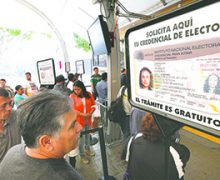
¿Ya terminó la era del Gobierno de un solo Hombre?
Is the One-Man Rule Era Over Yet?
El 2 de noviembre, una jueza emitió una orden judicial permanente impediendo al gobernador emitir más órdenes inconstitucionales. Los asambleístas Kevin Kiley y James Gallagher presentaron una demanda contra el abuso de poder del gobernador Newsom.
La juez dictaminó que Newsom violó la Constitución de California al emitir la Orden Ejecutiva N-67-20 relacionada con los protocolos de votación. La jueza asignada al caso de Newsom encontró una buena causa para una orden judicial permanente que le impedía emitir otras órdenes inconstitucionales.
“Gavin Newsom, en su capacidad oficial como gobernador del estado de California, tiene prohibido ejercer cualquier poder bajo la Ley de Servicios de Emergencia de California (Código de Gobierno $ 8550 et seq.) Que enmienda, altera o cambia la ley estatutaria existente o hace nueva ley estatutaria o política legislativa.”
En su blog, el asambleísta Kevin Kiley declaró que “la corte rechazó la extraordinaria afirmación de Newsom de que un estado de emergencia convierte a California en una autocracia y” centraliza los poderes del estado en manos del gobernador.” Esta es la base ilegal sobre la cual Newsom ha colapsado el sistema de controles y contrapesos de California, emitiendo 57 Órdenes Ejecutivas y cambiando más de 400 leyes unilateralmente. Es una “decisión provisional”, lo que significa que Newsom tiene unos días para tratar de persuadir al juez de que la cambie, pero eso rara vez sucede. Si bien Newsom puede apelar, estamos seguros de que la decisión tiene una base legal sólida y se mantendrá. La era del gobierno de un solo hombre en California ha terminado.”
La Senadora Melissa Melendez publicó en su página de Facebook la siguiente explicación del fallo del juez:
“Con respecto al caso judicial contra Newsom, sé que algunos de ustedes esperan que signifique que el bloqueo ha terminado. Desafortunadamente, no significa que el bloqueo haya terminado. El gobernador ha estado ocupado emitiendo órdenes ejecutivas, en total ha cambiado alrededor de 400 leyes existentes. El como gobernador no tiene la autoridad para cambiar o enmendar la ley. Entonces, la juez emitió una orden judicial para prohibir al gobernador emitir más órdenes ejecutivas que cambien o enmienden las leyes existentes.
Además dictaminó que la CESA, la Ley de Servicios de Emergencia de California, es constitucional y que el gobernador tiene derecho a ejercer la autoridad descrita en la ley.
El Artículo Decimotercero de la CESA contiene disposiciones específicas para un “Estado de Emergencia” proclamado, y la Sección 8627 de ese Artículo que establece:
“Durante un estado de emergencia, el gobernador, en la medida que lo considere necesario, tendrá autoridad completa sobre todas las agencias del gobierno estatal y el derecho a ejercer dentro del área designada todo el poder policial conferido al estado por la Constitución y las leyes del Estado de California a fin de llevar a cabo los propósitos de este capítulo. En ejercicio del mismo, promulgará, emitirá y hará cumplir las órdenes y reglamentos que considere necesarios, de acuerdo con las disposiciones de la Sección 8567.”
La CESA es esencialmente lo que le dio la autoridad para cerrar sectores del estado. Esencialmente, se permite suspender algunas leyes durante la pandemia hasta cierto punto, pero no se permite hacer nuevas leyes, ese es el trabajo de la legislatura. La cuestión era que el gobernador se excedía de sus poderes legales. La juez dictaminó que, de hecho, hizo precisamente eso, y prohibió cualquier otro acto que exceda su poder legal.”
Mientras tanto, los esfuerzos para destituir al gobernador Newsom aún están en marcha y se continuarán recolectando firmas hasta mediados de noviembre. Si desea imprimir, firmar y enviar por correo el formulario de remoción del gobernador, puede descargarlo de www.RecallGavin2020.com
Is the One-Man Rule Era Over Yet?
On November 2, a judge issued a permanent injunction restraining the Governor from issuing further unconstitutional orders. Assemblymen Kevin Kiley and James Gallagher filed a lawsuit challenging Governor Newsom’s abuse of powers.
The judge ruled that Newsom violated the Constitution of California when issuing Executive Order N-67-20 pertaining to voting protocols. The judge assigned to Newsom’s case found good cause for a permanent injunction restraining him from issuing any further unconstitutional orders.
“Gavin Newsom, in his official capacity as Governor of the State of California is enjoined and prohibited from exercising any power under the California Emergency Services Act (Government Code $8550 et seq.) which amends, alters, or changes existing statutory law or makes new statutory law o legislative policy.”
In his blog, Assemblyman Kevin Kiley stated that “The Court rejected Newsom’s extraordinary claim that a State of Emergency turns California into an autocracy and “centralizes the State’s powers in the hands of the Governor.” This is the unlawful basis on which Newsom has collapsed California’s system of checks and balances, issuing 57 Executive Orders, and changing over 400 laws unilaterally. It’s a “tentative ruling,” meaning Newsom has a few days to try to persuade the Judge to change it, but that rarely happens. While Newsom can appeal, we are confident the decision is on solid legal ground and will stand. The era of one-man rule in California is over.”
Senator Melissa Melendez posted on her Facebook page the following explanation to the judge’s ruling: “Regarding the court case against Newsom, I know some of you are hoping it means the lockdown is over. It does not mean the lockdown is over unfortunately. The Governor has been busy issuing executive orders, all told he has changed about 400 existing laws. He does not have the authority to change or amend law. So, the judge issued an injunction to prohibit the governor from issuing any more executive orders that change or amend existing laws.
The judge also ruled that the CESA, California Emergency Services Act, is constitutional, and that the Governor has the right to exercise the authority outlined within the Act.
Article Thirteen of the CESA contains provisions specific to a proclaimed “State of Emergency,’ and Section 8627 of that Article states:
“During a state of emergency, the Governor shall, to the extent he deems necessary, have complete authority over all agencies of the state government and the right to exercise within the area designated all police power vested in the state by the Constitution and laws of the State of California in order to effectuate the purposes of this chapter. In exercise thereof, he shall promulgate, issue, and enforce such orders and regulations as he deems necessary, in accordance with the provisions of Section 8567.”
The CESA is essentially what gave him the authority to close sectors of the state. Essentially, suspending some laws during the pandemic is allowable to a certain extent, but making new laws is not allowed, that is the job of the legislature. At issue was the Governor exceeding his legal powers. The judge ruled that he in fact did just that, and she placed a prohibition on any further acts that exceed his legal power.”
In the meantime, efforts to recall Governor Newsom are still underway and signatures will continue to be collected until mid-November. If you would like to print, sign, and mail the governor’s recall form, you may download it from www.RecallGavin2020.com

























